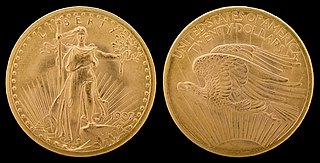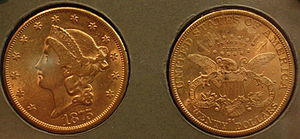A currency is a standardization of money in any form, in use or circulation as a medium of exchange, for example banknotes and coins. A more general definition is that a currency is a system of money in common use within a specific environment over time, especially for people in a nation state. Under this definition, the British Pound Sterling (£), euros (€), Japanese yen (¥), and U.S. dollars (US$)) are examples of (government-issued) fiat currencies. Currencies may act as stores of value and be traded between nations in foreign exchange markets, which determine the relative values of the different currencies. Currencies in this sense are either chosen by users or decreed by governments, and each type has limited boundaries of acceptance - i.e. legal tender laws may require a particular unit of account for payments to government agencies.

A gold standard is a monetary system in which the standard economic unit of account is based on a fixed quantity of gold. The gold standard was the basis for the international monetary system from the 1870s to the early 1920s, and from the late 1920s to 1932 as well as from 1944 until 1971 when the United States unilaterally terminated convertibility of the US dollar to gold, effectively ending the Bretton Woods system. Many states nonetheless hold substantial gold reserves.
The Specie Circular is a United States presidential executive order issued by President Andrew Jackson in 1836 pursuant to the Coinage Act. It required payment for government land to be in gold and silver.
The Specie Payment Resumption Act of January 14, 1875 was a law in the United States that restored the nation to the gold standard through the redemption of previously-unbacked United States Notes and reversed inflationary government policies promoted directly after the American Civil War. The decision further contracted the nation's money supply and was seen by critics as an exacerbating factor of the so-called Long Depression, which struck in 1873.

The Panic of 1837 was a financial crisis in the United States that touched off a major depression, which lasted until the mid-1840s. Profits, prices, and wages went down, westward expansion was stalled, unemployment went up, and pessimism abounded.

Thomas Hart Benton, nicknamed "Old Bullion", was a United States Senator from Missouri. A member of the Democratic Party, he was an architect and champion of westward expansion by the United States, a cause that became known as Manifest Destiny. Benton served in the Senate from 1821 to 1851, becoming the first member of that body to serve five terms.

Executive Order 6102 is an executive order signed on April 5, 1933, by US President Franklin D. Roosevelt "forbidding the hoarding of gold coin, gold bullion, and gold certificates within the continental United States." The executive order was made under the authority of the Trading with the Enemy Act of 1917, as amended by the Emergency Banking Act in March 1933.
This history of central banking in the United States encompasses various bank regulations, from early wildcat banking practices through the present Federal Reserve System.

Wildcat banking was the issuance of paper currency in the United States by poorly capitalized state-chartered banks. These wildcat banks existed alongside more stable state banks during the Free Banking Era from 1836 to 1865, when the country had no national banking system. States granted banking charters readily and applied regulations ineffectively, if at all. Bank closures and outright scams regularly occurred, leaving people with worthless money.
The history of the United States dollar began with moves by the Founding Fathers of the United States of America to establish a national currency based on the Spanish silver dollar, which had been in use in the North American colonies of the United Kingdom for over 100 years prior to the United States Declaration of Independence. The new Congress's Coinage Act of 1792 established the United States dollar as the country's standard unit of money, creating the United States Mint tasked with producing and circulating coinage. Initially defined under a bimetallic standard in terms of a fixed quantity of silver or gold, it formally adopted the gold standard in 1900, and finally eliminated all links to gold in 1971.
Pet banks is a derogatory term for state banks selected by the U.S. Department of Treasury to receive surplus Treasury funds in 1833. Pet banks are sometimes confused with wildcat banks. Although the two are distinct types of institutions that arose concomitantly, some pet banks were known to also engage in practices of wildcat banking. They were chosen among the big U.S. banks when President Andrew Jackson vetoed the recharter for the Second Bank of the United States, proposed by Henry Clay four years before the recharter was due. Clay intended to use the rechartering of the bank as a topic in the upcoming election of 1832. The charter for the Second Bank of the United States, which was headed by Nicholas Biddle, was for a period of twenty years beginning in 1816, but Jackson's distrust of the national banking system led to Biddle's proposal to recharter early, and the beginning of the Bank War. Jackson cited four reasons for vetoing the recharter, each degrading the Second Bank of the United States in claims of it holding an exorbitant amount of power. These reasons for vetoing the recharter were centered around Jackson's belief in his role as the representative of the common man. Amos Kendall, who was the intellectual driving force behind Jackson's 1832 election and Jackson himself, led Jackson to believe that the bank posed a political threat to Jackson. Kendall cautioned Jackson that unless he got rid of the Second Bank of the United States, it would find a way to elect its own candidate to the White House after Jackson was gone. Jackson saw the bank as a threat to the common man and "the great enemy of republicanism", and argued that as long as the national bank existed, the working class was constantly in danger of losing their stake in government.
The Independent Treasury was the system for managing the money supply of the United States federal government through the U.S. Treasury and its sub-treasuries, independently of the national banking and financial systems. It was created on August 6, 1846 by the 29th Congress, with the enactment of the Independent Treasury Act of 1846. It was expanded with the creation of the national banking system in 1863. It functioned until the early 20th century, when the Federal Reserve System replaced it. During this time, the Treasury took over an ever-larger number of functions of a central bank and the U.S. Treasury Department came to be the major force in the U.S. money market.

The Bank War was a political struggle that developed over the issue of rechartering the Second Bank of the United States (B.U.S.) during the presidency of Andrew Jackson (1829–1837). The affair resulted in the shutdown of the Bank and its replacement by state banks.

Money is any item or verifiable record that is generally accepted as payment for goods and services and repayment of debts, such as taxes, in a particular country or socio-economic context. The primary functions which distinguish money are as a medium of exchange, a unit of account, a store of value and sometimes, a standard of deferred payment.

Hard-times tokens are American large or half cent-sized copper tokens, struck from about 1833 through 1843, serving as unofficial currency. These privately made pieces, comprising merchant, political and satirical pieces, were used during a time of political and financial crisis in the United States.

The United States dollar is the official currency of the United States and several other countries. The Coinage Act of 1792 introduced the U.S. dollar at par with the Spanish silver dollar, divided it into 100 cents, and authorized the minting of coins denominated in dollars and cents. U.S. banknotes are issued in the form of Federal Reserve Notes, popularly called greenbacks due to their predominantly green color.

Fiat money is a type of currency that is not backed by any commodity such as gold or silver. It is typically designated by the issuing government to be legal tender. Throughout history, fiat money was sometimes issued by local banks and other institutions. In modern times, fiat money is generally authorized by government regulation.
The Coinage Act of 1857 was an act of the United States Congress which ended the status of foreign coins as legal tender, repealing all acts "authorizing the currency of foreign gold or silver coins". Specific coins would be exchanged at the Treasury and re-coined. The act is divided into seven sections.
This article is about the history of monetary policy in the United States. Monetary policy is associated with interest rates and availability of credit.
The Second Bank of the United States opened in January 1817, six years after the First Bank of the United States lost its charter. The Second Bank of the United States was headquartered in Carpenter's Hall, Philadelphia, the same as the First Bank, and had branches throughout the nation. The Second Bank was chartered by many of the same congressmen who in 1811 had refused to renew the charter of the original Bank of the United States. The predominant reason that the Second Bank of the United States was chartered was that in the War of 1812, the U.S. experienced severe inflation and had difficulty in financing military operations. Subsequently, the credit and borrowing status of the United States was at its lowest level since its founding.













